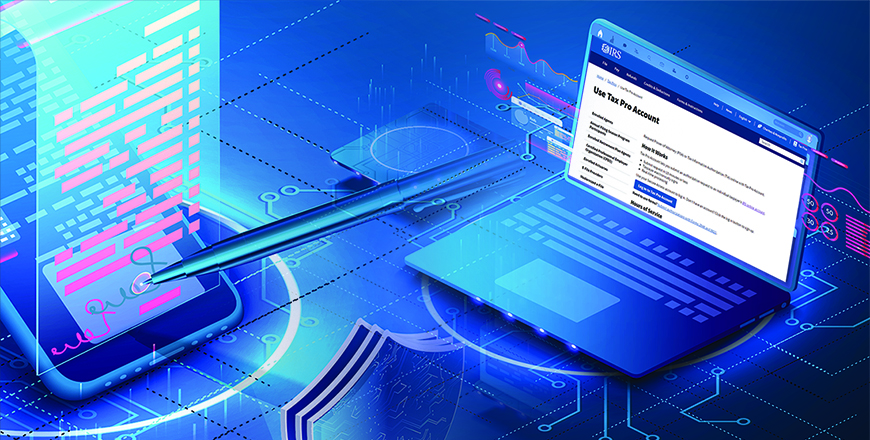Get a closer look at how the IRS turned the challenging demands of the pandemic into opportunities to meet taxpayers’ needs and to serve their representatives.
Get to know the IRS, its people and the issues that affect taxpayers
By Harrison Smith
CL-22-02, January 20, 2022
As difficult as these last months have been, we’ve found demands from challenging times can evolve into opportunities to meet taxpayers’ needs and to better serve their representatives. Never was this more evident than during this pandemic.
The immediate need to minimize in-person contact to protect taxpayers and our employees led the IRS to take steps toward increasing digital interactions. We’ve learned digital options are fundamental to tax administration and are offering these flexibilities as we apply them to our programs. Today, I want to highlight two options available now and worthy of a Closer Look: using electronic or digital signatures on certain paper-filed forms and emailing documents to resolve examination and collection activities. These expanded digital options enhance the taxpayer experience and build upon the earlier addition of new virtual services and online tools like electronic signatures for third party authorizations and an online account for tax professionals.
You asked; we listened
Early on during the pandemic, taxpayer representatives expressed concerns with securing handwritten signatures for forms they had to file or maintain on paper. We listened, and in March 2020 we issued guidance to our employees allowing electronic or digital signatures on certain forms that normally required a handwritten or “wet” signature.
We’ve seen a positive response since the start of this special step, and we’ve heard how it’s helped facilitate relationships with clients during this challenging time. We listened again and expanded the original list of forms for which we’ll now accept an electronic or digital signature to include most Form 706 series returns related to estate taxes, Form 1120 series returns that cannot be e-filed and many other forms. You can find a complete list of the forms in this fact sheet, and you can find the forms on IRS.gov and through tax professionals’ software products. Currently, these flexibilities are authorized through October 31, 2023, and we are actively working to extend them based on your interest.
For those who choose to make use of these new digital options, there are a few things I’d like to point out. First, these selected paper forms are not available through IRS e-file. Second, these forms were identified because they are considered low risk for fraud or malfeasance so this option may not be suitable for other forms. And third, electronic and digital signatures appear in many forms when printed and may be created by many different technologies. There are several commercial products available, and we don’t require any specific one – the choice is yours.
I also want to note that these changes are a direct result of feedback and suggestions we’ve received. We value input and partnership from our stakeholders and taxpayers because outside viewpoints are important and help us better support all taxpayers.
An additional option at your discretion during compliance interactions
Along with the form exception, we’ve offered another opportunity to address the pandemic’s effect on our compliance operations and communications. We now allow taxpayers and taxpayer representatives to send encrypted documents and receive documents from us using email during certain compliance interactions.
We’ll also accept images of signatures and digital signatures on these documents related to compliance interactions:
- Extensions of statute of limitations on assessment or collection,
- Waivers of statutory notices of deficiency and consents to assessment,
- Agreements to specific tax matters or tax liabilities (closing agreements) and
- Any other statement or form traditionally collected by IRS personnel outside standard filing procedures.
This email option is only available for those working with an enforcement employee to resolve an examination or collection activity, and the choice to transmit documents electronically is solely up to each individual. All existing and previously allowable means of receiving and transmitting information, such as eFax, established secured messaging systems or postal mail remain available to anyone who chooses that option.
Some important points to remember:
- The IRS will never initiate contact by email, but this option may be requested during an ongoing compliance interaction. Be aware of tax scams. Don’t exchange data with anyone claiming to be an IRS employee if you haven’t separately received a notice by mail of an examination or collection action and established initial contact by phone.
- Protecting taxpayer information is of utmost importance. Those who choose to email us must follow our guidance on the steps to take to securely transmit and receive documents. Minimize personally identifiable information in electronic messages and use encryption and password protection to protect the security of any documents transmitted by email. The U.S. Department of the Treasury website has instructions on “How to encrypt/password protect Microsoft Office and Adobe Acrobat (PDF) documents.”
Again, this email option is only available for those working with an enforcement employee on an examination or collection activity. I encourage others who need to contact us to visit the Let Us Help You page on IRS.gov. Along with telephone and local assistance, the page has many online tools and resources to help answer questions. The page is available in English, Spanish, Chinese (Simplified and Mandarin), Korean, Russian, Vietnamese and Haitian Creole.
Final thoughts
I understand how electronic signatures and other flexibilities are important to taxpayers and their representatives. They’re part of a larger effort underway at the IRS to make processes easier for everyone. This effort provides new or different tools as well as different ways of doing business. We’ll continue to review our processes to decide where long-term actions can help reduce burden for taxpayers and their representatives. I’m excited to watch how options evolve as we follow our current path toward flexible, digital options.
Harrison Smith
Co-Director IRS Enterprise Digitalization and Case Management Office
About the author
Harrison Smith is Co-Director of the Internal Revenue Service (IRS) Enterprise Digitalization and Case Management Office. In this role, he spearheads IRS efforts to modernize systems, simplify business processes, and empower taxpayers and IRS employees to rapidly resolve issues in simplified digital environments.
Help for Taxpayers YouTube Video
A Closer Look
Read all our posts about a variety of timely issues of interest to taxpayers and the tax community
Subscribe
The IRS offers several e-News subscriptions on a variety of tax topics. Subscribe to get email alerts when new content is posted.

 )
or https:// means you've safely connected to the .gov website. Share sensitive information only on official, secure websites.
)
or https:// means you've safely connected to the .gov website. Share sensitive information only on official, secure websites.



